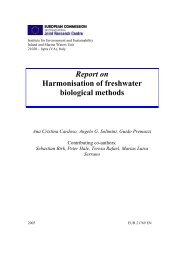Lakes and Watercourses
Lakes and Watercourses
Lakes and Watercourses
You also want an ePaper? Increase the reach of your titles
YUMPU automatically turns print PDFs into web optimized ePapers that Google loves.
TABLE 13.<br />
CURRENT CONDITIONS: turbidity<br />
Class Description FNU units<br />
1 No or insignificant turbidity ≤ 0.5<br />
2 Slightly turbid 0.5 – 1.0<br />
3 Moderately turbid 1.0 – 2.5<br />
4 Substantially turbid 2.5 – 7.0<br />
5 Highly turbid > 7.0<br />
In lakes, turbidity is classified using seasonal mean values (May –<br />
October) over one year, based on monthly readings taken in surface<br />
water (0.5 m) or in samples taken at several depths. Assessment of<br />
watercourses should be based on samples taken 12 times over one year.<br />
The assessment scale classifies group concentration levels typical of<br />
Swedish lakes <strong>and</strong> watercourses <strong>and</strong> is not related to biological or<br />
microbial effects.<br />
Turbidity readings using different methods yield somewhat different<br />
results. The previous Swedish st<strong>and</strong>ard expressed turbidity as FTU<br />
(formazine turbidity units). The present Swedish <strong>and</strong> ISO st<strong>and</strong>ard states<br />
readings in the form of FNU (formazine nephelometric units). Other<br />
methods involve readings expressed as NTU (nephelometric turbidity<br />
units) or JTU (Jackson turbidity units). For practical purposes, 1 FTU = 1<br />
FNU = 1 NTU ≈ JTU.<br />
TABLE 14.<br />
CURRENT CONDITIONS: Secchi depth in lakes<br />
Class Description Depth (m)<br />
1 Very great Secchi depth ≥ 8<br />
2 Great Secchi depth 5 – 8<br />
3 Moderate Secchi depth 2.5 – 5<br />
4 Little Secchi depth 1 – 2.5<br />
5 Very little Secchi depth < 1<br />
34















![Accommodation booking form [PDF]](https://img.yumpu.com/39471785/1/184x260/accommodation-booking-form-pdf.jpg?quality=85)

